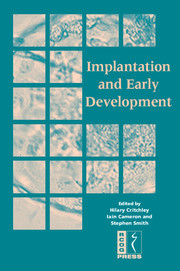Book contents
- Frontmatter
- Contents
- DECLARATION OF INTEREST
- Participants
- Preface
- SECTION 1 PREPARATION FOR IMPLANTATION – THE UTERINE ENVIRONMENT
- SECTION 2 THE EMBRYO
- SECTION 3 LESSONS FROM ANIMAL MODELS (TRANSGENICS) AND NOVEL TECHNOLOGIES
- SECTION 4 CLINICAL SEQUELAE
- 17 Sporadic early pregnancy loss: aetiology and management
- 18 Recurrent miscarriage – the role of prothrombotic disorders
- 19 Reproductive disorders and pregnancy outcome
- 20 Risk factors for first-trimester miscarriage: summary of results from the National Women's Health Study
- 21 Single-embryo transfer
- 22 Paediatric outcome after assisted reproductive technology
- SECTION 5 CONSENSUS VIEWS
- Index
17 - Sporadic early pregnancy loss: aetiology and management
from SECTION 4 - CLINICAL SEQUELAE
Published online by Cambridge University Press: 05 June 2014
- Frontmatter
- Contents
- DECLARATION OF INTEREST
- Participants
- Preface
- SECTION 1 PREPARATION FOR IMPLANTATION – THE UTERINE ENVIRONMENT
- SECTION 2 THE EMBRYO
- SECTION 3 LESSONS FROM ANIMAL MODELS (TRANSGENICS) AND NOVEL TECHNOLOGIES
- SECTION 4 CLINICAL SEQUELAE
- 17 Sporadic early pregnancy loss: aetiology and management
- 18 Recurrent miscarriage – the role of prothrombotic disorders
- 19 Reproductive disorders and pregnancy outcome
- 20 Risk factors for first-trimester miscarriage: summary of results from the National Women's Health Study
- 21 Single-embryo transfer
- 22 Paediatric outcome after assisted reproductive technology
- SECTION 5 CONSENSUS VIEWS
- Index
Summary
Introduction
Sporadic early pregnancy loss occurs in approximately 15% of clinically recognised pregnancies. Despite its high prevalence, a significant amount of confusion exists surrounding the aetiology and management of miscarriage, and this is partly due to the lack of a defined terminology. An optimal terminology would reflect both ultrasound findings and aetiology. At present it is frequently assumed that women with three consecutive miscarriages are losing normal pregnancies but those with only one miscarriage are losing abnormal ones. However, recent data refute this assumption. It is now very important that the diagnosis of miscarriage is refined and women are given more information regarding the aetiology of each pregnancy loss. This requirement can, however, lead to conflicts between treatment modalities and the need for an accurate diagnosis.
Terminology
First-trimester miscarriage
In the past, miscarriage has been referred to as ‘blighted ovum’ to indicate the absence of an embryo at a very early stage of pregnancy. This is no longer an acceptable term as it implies the mother is at fault. The term ‘missed miscarriage’ is currently in frequent use to refer to a pregnancy that the uterus does not pass for a prolonged time after fetal demise. However, ‘missed miscarriage’ implies either the patient or the medical services are at fault for missing the diagnosis and it is an unwieldy and confusing term.
Keywords
- Type
- Chapter
- Information
- Implantation and Early Development , pp. 219 - 228Publisher: Cambridge University PressPrint publication year: 2005



